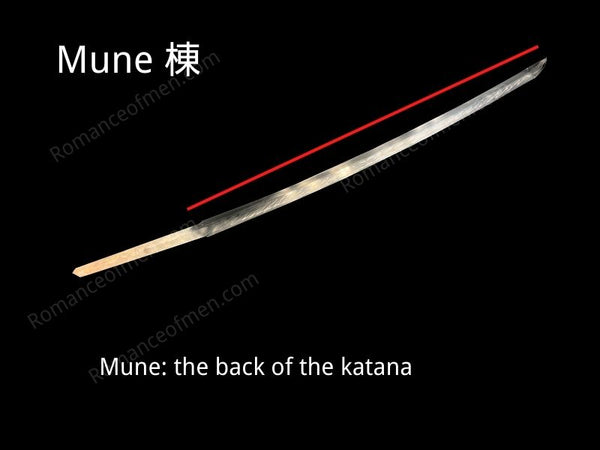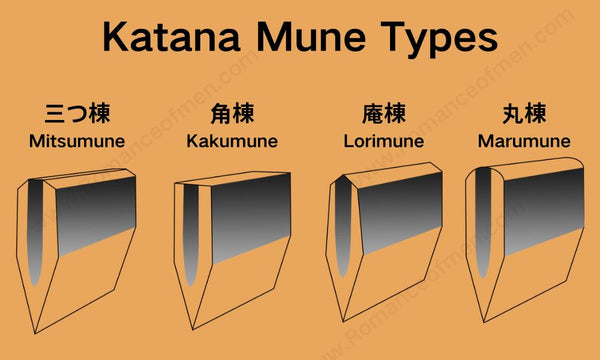Katana Mune Definite guide to understand the back of samurai sword
Katana Mune: Everything you need to know about the back of Katana Sword
Katanas are quite fascinating and even more complex. In fact, this complexity is what makes them so unique and interesting. You might have heard about something called the Mune and wondered what it might be. And also, it’s purpose of being on the katana. Well, here I discuss that in great detail.
Table of Content
- What is Mune "棟" in Katana?
- The Purpose Of The Katana Mune
- Materials Used For The Mune
- Types of Katana Mune
- Interesting Mune Facts
What is Mune "棟" in Katana?

The mune is the back of the katana sword. In Japanese mune is "棟", also known as "峰".
For practical purposes, the mune offers several advantages. Firstly, it helps to balance the weight of the katana, there are different types of mune designed for different types of blade geometry. Compared to a double-edged sword, the mune can be pressed with hand during encounters where swords are crossed, provide more force. The mune minimizes the risk of self-injury and allows for the possibility of using it to strike.
From the perspective of sword appreciation, the mune is not just a functional feature but also a treasure trove of information. It can reveal the era in which the sword was forged, identify the craftsman, and provide insights into their unique style.
The Purpose Of The Katana Mune
Katana Mune for the sword integrity
The thickness of a katana, referred to as "kasane" (重ね), is crucial for its sharpness and structural integrity. When measured at the mune it's called "mune-kasane" (棟重ね), and this thickness plays a very important role in the blade's cutting performance. A thinner kasane, particularly towards the edge of the blade, enhances the katana's sharpness, making it more effective for cutting. This thinness is achieved while maintaining a certain thickness at the mune to ensure the sword can absorb impacts without bending easily.
There are blade geomatry like 冠落造り (Kanmuri-otoshi-zukuri), 菖蒲造り (Shōbu-zukuri) and 鵜首造り (Unokubi-zukuri), part of their mune are significantly slim. We can even see 両刃造り (Moroha-zukuri), that the mune is sharp like a double edge sword.
Katana Mune used for blocking
Some said that the back of a katana can serve as a defensive tool to block attacks. However, based on our experience, this move is very challenging to execute. It requires quickly twisting the blade to block an incoming strike and then swiftly rotating it back to a position for counterattack. This action is not only difficult but also risky. Historical evidence from katanas that have been passed down—especially those used in battle—supports this assertion. Most of these swords bear scratches or notches along the ridge, rather than on the mune.
Another factor that casts doubt on the use of the mune for blocking is the vulnerability of a katana with edge chips. Blocking with the back of a blade that has chips can break the sword easily. In the heat of battle, wielding a damaged or broken sword is the last thing you want to do.
Mune-uchi "峰打" Attack with Katana Mune
One of the purposes of having the mune seems to be to strike down one's opponent without killing them or severely injuring them. Katanas are single-edged swords. This is one of their defining characteristics. This technique is called Mune-uchi "峰打".
Mune-uchi is very popular in Japanese movies and dramas. However, there’s little historical evidence that mune-uchi was actually practiced. Furthermore, samurai rarely draw their swords unless they intend to fight until the very end. We think Mune-uchi is more of a fictional creation.
In the manga "Rurouni Kenshin", Kenshin used a "reverse-blade sword", a katana designed with the edge and back reversed. This might be a better katana for Mune-uchi. We have this replicated sword in real life, but using it feels not very nature because the weight distribution is different.
There are advantages and disadvantages to both single-edged and double-edged swords. A single-edged sword doesn't harm the wielder. Having a mune also helps to make the blade much stronger and sturdier.
Materials Used For The Mune
A katana's back should be soft to absorb shocks and prevent the blade from breaking when hitting hard targets. So material with lower carbon content is ideal, making it softer and more flexible to absorb impacts effectively.
In ancient Japan katana was made of a special Japanese steel called the Tamahagane "玉鋼". During the katana making process, there is a step called Kowari "小割", steel with different carbon content are selected to be used in different parts of a katana. Among them, the ones with low carbon content are called " Kawagane (皮鉄 / 皮金)" or Munegane (棟鉄 / 棟金) , they are more flexible and will be used for the katana mune.
After the katana blade is formed, It will went thought a special quenching process called clay tempered. For tempering the mune a thicker layer of clay is applied on to it. It makes the mune comparably softer than the edge. Allowing it to handle a lot of stress and force and provide support to the blade. It also provides great impact absorption to aid in blocking.
Types of Katana Mune

There are different types of mune. The mune is roughly divided into 4 types: flat and roofed in different shapes:
Mitsumune (三つ棟 / True mune): Has a trapezoidal shape with three surfaces, known as "True mune" (真の棟). Common in swords from the Heian period onwards, especially in Yamashiro (山城伝) and Sagami (相州伝) swords.
Marumune (丸棟 / Round mune): Features a semi-circular cross-section, also called "Grass mune" (草の棟), frequently found in swords from Kyushu (九州) and Hokuriku (北陸).
Kakumune (角棟 / Angle mune): Also known as "Flat mune" (平棟), characterized by a flat top without ridges. It's the oldest style, mostly seen in Jokoto 上古刀, but became rare after swords were made curved.
Lorimune (庵棟 / Row mune): Identified by a sharp peak, referred to as "Row mune" (行の棟), common in Odachi. The height of the mune is described as "Iori", with "high Iori" (庵高い) having a steep incline and "low Iori" (庵低い) having a gentle slope.
Interesting Mune Facts
Different kinds of mune are popular in other schools and traditions. The Yamato traditional schools also use the Iori mune.
While the Iori mune is more common in Bizen traditions, the Mitsumune, is popular in the Soshu and Yamato traditions.
In the famous manga Rurouni Kenshin, the main character Himura Kenshin is using a reversed blade katana, which means his katana has sharp Mune and dull edge. That katana was meant not to kill.
In our custom katana section, you can select sharp or unsharp for your katana.
Mune FAQs
- Why is the mune tempered with thicker clay?
Ans. The purpose of the mune is to provide impact resistance to the katana. And the harder something is, the more brittle it becomes. Thicker clay layers on the mune makes this portion soft compared to the blade edge which is needed to be hard to retain sharpness. This softness allows it to easily take blows, block attacks and keep the sword in one piece.
- Q. Can the mune of a katana attack the opponent without fatally injuring them?
Ans. In practice, it's difficult and almost impossible to attack an opponent without injuring them. Attacking your opponent without cutting them is called mune-uchi. It’s mostly seen in movies and dramas. But in reality, when samurai used to draw their swords, they intended to kill the opponent.
Wrapping Up
The mune is still a special part of a katana blade, and a lot of skill goes into perfecting it. Although the elaborate movie scenes might not be true, but the level of craftsmanship that goes into creating them is really impressive.
Check out our complete katana parts guide here for more katana components.





















